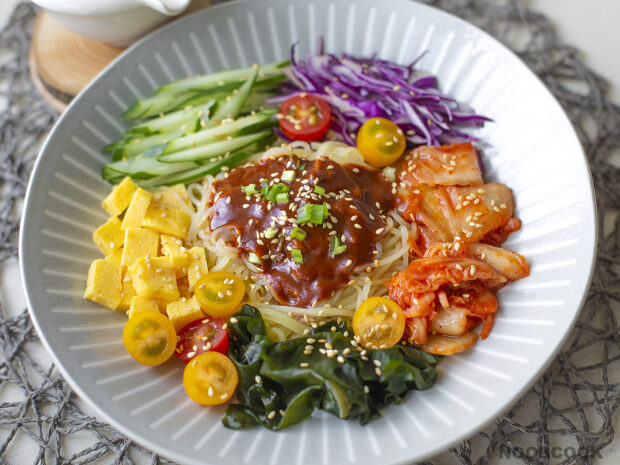Low Carb Bibim Guksu

I made a low carb bibim guksu (Korean spicy mixed noodles) with lots of accompanying colourful vegetable toppings using some of the leftover toppings ingredients from my low carb hiyashi chuka (Japanese cold noodles) the day before. To make it low carb, I swap the usual chewy soba or somen with (almost) zero-calorie ‘miracle’ shirataki noodles. I made up for eating cold noodles during the cooler rainy season by upping the heat level of my spicy noodles. This is not an authentic recipe for bibim guksu due to the ingredient tweaks I made – furthermore it also was not served it in a Korean stainless steel bowl (I don’t have it). But it certainly satisfied my craving for Korean food as the taste was good!
Related Recipe:

See Also:
- Korean Spicy Cucumber Salad
- Korean Ginseng Chicken Soup (Samgyetang)
- More Low Carb Recipes
- Easy Korean Cooking

Thanks to the shirataki noodles, I am now able to enjoy such otherwise forbidden dishes during dieting! As a person without a steely determination, such low carb recipe adaptation is my middle way of giving in to my weak resolve – eating like this occasionally minimises my cravings for eating a big carb dish.
STEP-BY-STEP PHOTOS
Step 1: Make the spicy noodle sauce

The main ingredient of my sauce is gochujang and roasted sesame salad dresssing (goma salad sauce). I replaced the usual soy sauce with goma salad sauce, as I have many sachets of the salad sauce to use up. I like that the goma sauce gives an additional nutty and smooth savoury depth to the sauce. I also season the noodle sauce with sesame oil and garlic & onion powder (optional; I use what I have in the fridge). To emulsify the sauce, I used Coke Zero which provides sweetness without the calories. Lastly, to make the noodles more spicy, I added lots of chilli powder. This sauce turns out really nice! It can keep well in the fridge for days so you can prepare it in advance.
Step 2: Prepare the noodles and toppings

- (1): As a low carb substitute for ramen noodles, I am using rice shirataki which is very low in calories. You can also use regular white shirataki noodles.
- (2): Drain the liquid from the pouch and place the drained noodles in the pan. Fry it without any oil to remove excess moisture from the noodles. This extra step greatly improved the noodles ability to absorb the noodle sauce. Cool down the noodles with ice cubes or put it in the fridge.
- (3): Toppings: Rehydrated kelp (wakame), ready-to-eat tamagoyaki, cherry tomatoes, cucumber and purple (red) cabbage. They took less than 5 minutes to prepare. These toppings add colour, crunch and texture to the bowl.
- (4): Cut kimchi. It adds a pleasant depth of sour & spicy umami crunch to the overall dish.
Step 3: Assemble the dish

Place the noodles in the middle of a large plate surrounded by all the colourful toppings, accompanied by the sauce at the side. You can serve the dish in this way if you like.
Another way of serving the noodles


Alternatively, coat only the noodles with some of the spicy noodle sauce. This is my preferred way of serving the dish on the table, because one get to see that the noodles are spicy at a glance, while still enjoying the visual of the colourful toppings :p

For the first few bites, I like to enjoy the noodles with the sauceless toppings first (pictured above), before coating everything in the sauce. Serving everything already mixed in the sauce is another way to serve this dish, just that mine just looked too messy and unglamorous :/
Whichever way you serve it, this low carb bibim guksu is delicious!












Your daily food always looks so colourful, and appetizing! I used to eat lots of shirataki noodles..you just have me crave some now :-)
I wish I could eat like you!